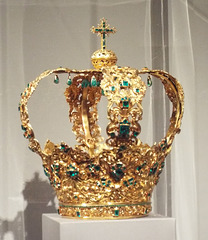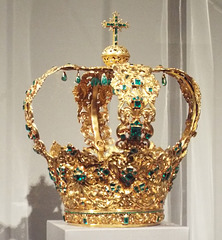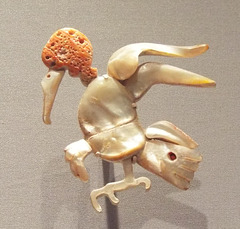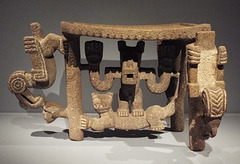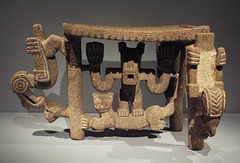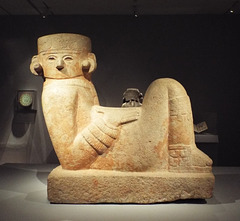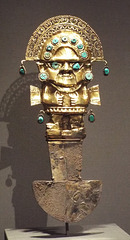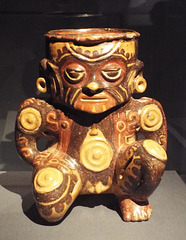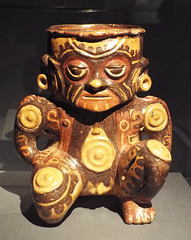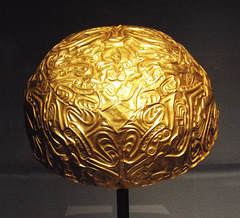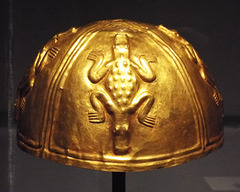
Metropolitan Museum- Special Exhibitions
Folder: Metropolitan Museum of Art
Crown of the Virgin of the Immaculate Conception i…
| |
|
Crown of the Virgin of the Immaculate Conception, known as the Crown of the Andes
Date: Ca. 1660 (diadem) and ca. 1770 (arches)
Geography: Made in Colombia
Culture: Colombian; Popayán
Medium: Gold, repoussé and chased; emeralds
Dimensions: 13 1/2 in. (34.3 cm)
Body diameter: 13 1/4 in. (33.7 cm)
Classification: Gold
Credit Line: Purchase, Lila Acheson Wallace Gift, Acquisitions Fund and Mary Trumbull Adams Fund, 2015
Accession Number: 2015.437
This imperial gold crown, worked in repoussé and set with nearly 450 emeralds, was made to adorn a sculpture of the Virgin Mary venerated in Popayán, Colombia. A symbol of the Virgin's divine rulership, the crown is surmounted by four arches topped by a cross-bearing orb that symbolizes Christ's dominion over the world. The crown's diadem, an openwork band of foliate scrolls, is embellished with emeralds mounted in the form of flowers, a reference to the Virgin's purity. This combination of gold and emeralds also reflects the aesthetic preferences of Precolumbian cultures of Colombia and Panama.
Text from: www.metmuseum.org/art/collection/search/21698
Crown of the Virgin of the Immaculate Conception i…
| |
|
Crown of the Virgin of the Immaculate Conception, known as the Crown of the Andes
Date: Ca. 1660 (diadem) and ca. 1770 (arches)
Geography: Made in Colombia
Culture: Colombian; Popayán
Medium: Gold, repoussé and chased; emeralds
Dimensions: 13 1/2 in. (34.3 cm)
Body diameter: 13 1/4 in. (33.7 cm)
Classification: Gold
Credit Line: Purchase, Lila Acheson Wallace Gift, Acquisitions Fund and Mary Trumbull Adams Fund, 2015
Accession Number: 2015.437
This imperial gold crown, worked in repoussé and set with nearly 450 emeralds, was made to adorn a sculpture of the Virgin Mary venerated in Popayán, Colombia. A symbol of the Virgin's divine rulership, the crown is surmounted by four arches topped by a cross-bearing orb that symbolizes Christ's dominion over the world. The crown's diadem, an openwork band of foliate scrolls, is embellished with emeralds mounted in the form of flowers, a reference to the Virgin's purity. This combination of gold and emeralds also reflects the aesthetic preferences of Precolumbian cultures of Colombia and Panama.
Text from: www.metmuseum.org/art/collection/search/21698
Mosaic of a Bird in the Metropolitan Museum of Art…
| |
|
Mosaic of Bird
Date: A.D. 600–800
Geography: Guatemala, Petén
Culture: Maya
Medium: Mother-of-pearl, Spondylus shell
Dimensions: H. 6 1/4 × W. 4 3/16 in. (15.8 × 10.7 cm)
Classifications: Shell-Ornaments, Jewelry
Credit Line: Museo Nacional de Arqueología y Etnología, Guatemala City (17.7.21.210a)
The Maya death god—with a distended belly simulating a rotting corpse—wears a towering headdress composed of mother-of-pearl with a trefoil crown, a symbol of Maya rulership. The bird’s bare red head and white body possibly identify it as a king vulture.
Text from: www.metmuseum.org/art/collection/search/722320
Mosaic of a Bird in the Metropolitan Museum of Art…
| |
|
Mosaic of Bird
Date: A.D. 600–800
Geography: Guatemala, Petén
Culture: Maya
Medium: Mother-of-pearl, Spondylus shell
Dimensions: H. 6 1/4 × W. 4 3/16 in. (15.8 × 10.7 cm)
Classifications: Shell-Ornaments, Jewelry
Credit Line: Museo Nacional de Arqueología y Etnología, Guatemala City (17.7.21.210a)
The Maya death god—with a distended belly simulating a rotting corpse—wears a towering headdress composed of mother-of-pearl with a trefoil crown, a symbol of Maya rulership. The bird’s bare red head and white body possibly identify it as a king vulture.
Text from: www.metmuseum.org/art/collection/search/722320
Flying-Panel Metate in the Metropolitan Museum of…
| |
|
Flying-Panel Metate
Date: A.D. 400–800
Geography: Costa Rica
Culture: Central Region
Medium: Volcanic stone
Dimensions: H. 18 × W. 31 3/4 × D. 32 7/8 in. (45.7 × 80.6 × 83.5 cm)
Classification: Stone-Furniture
Credit Line: Colección Museo Nacional de Costa Rica/CCSS, San José (73.981)
Artists transformed relatively common materials such as volcanic stone into luxury objects. Each leg of this metate (a grinding stone possibly used as a ceremonial stool) features stylized vultures with trophy heads. Below, a feline—perhaps a jaguar or puma—bares its teeth and grasps one leg of the stool while its tail connects to the metate’s surface. A creature with the snout and fangs of a crocodile and the upright stance of a human is on the feline’s back.
Text from: www.metmuseum.org/art/collection/search/722317
Flying-Panel Metate in the Metropolitan Museum of…
| |
|
Flying-Panel Metate
Date: A.D. 400–800
Geography: Costa Rica
Culture: Central Region
Medium: Volcanic stone
Dimensions: H. 18 × W. 31 3/4 × D. 32 7/8 in. (45.7 × 80.6 × 83.5 cm)
Classification: Stone-Furniture
Credit Line: Colección Museo Nacional de Costa Rica/CCSS, San José (73.981)
Artists transformed relatively common materials such as volcanic stone into luxury objects. Each leg of this metate (a grinding stone possibly used as a ceremonial stool) features stylized vultures with trophy heads. Below, a feline—perhaps a jaguar or puma—bares its teeth and grasps one leg of the stool while its tail connects to the metate’s surface. A creature with the snout and fangs of a crocodile and the upright stance of a human is on the feline’s back.
Text from: www.metmuseum.org/art/collection/search/722317
Pendant with Figure in the Metropolitan Museum of…
| |
|
Pendant with Figurine
Date: A.D. 600–1000
Geography: Peru
Culture: Wari
Medium: Spondylus shell and stone inlay, metal
Dimensions: H. 5 1/4 × W. 4 1/2 × D. 2 in. (13.3 × 11.4 × 5.1 cm)
Classification: Shell-Ornaments
Credit Line: Fowler Museum at UCLA, Los Angeles, Gift of Mr. and Mrs. Herbert L. Lucas, Jr. (X88-255)
This figurine depicts a high-status Wari man wearing a tapestry tunic, earspools, and a headdress; he is perched on a Spondylus princeps valve. The tunic—inlaid with other rare, imported materials, including mother-of-pearl—demonstrates the imperial reach of the Wari Empire.
Text from: www.metmuseum.org/art/collection/search/722154
Pendant with Figure in the Metropolitan Museum of…
| |
|
Pendant with Figurine
Date: A.D. 600–1000
Geography: Peru
Culture: Wari
Medium: Spondylus shell and stone inlay, metal
Dimensions: H. 5 1/4 × W. 4 1/2 × D. 2 in. (13.3 × 11.4 × 5.1 cm)
Classification: Shell-Ornaments
Credit Line: Fowler Museum at UCLA, Los Angeles, Gift of Mr. and Mrs. Herbert L. Lucas, Jr. (X88-255)
This figurine depicts a high-status Wari man wearing a tapestry tunic, earspools, and a headdress; he is perched on a Spondylus princeps valve. The tunic—inlaid with other rare, imported materials, including mother-of-pearl—demonstrates the imperial reach of the Wari Empire.
Text from: www.metmuseum.org/art/collection/search/722154
Chac Mool in the Metropolitan Museum of Art, May 2…
| |
|
Chac Mool
Date: A.D. 800–1250
Geography: Mexico, Yucatan
Culture: Maya
Medium: Stone
Dimensions: H. 36 1/2 × W. 41 × D. 22 1/4 in., Wt. 1200 lb. (92.7 × 104.1 × 56.5 cm, 544316.429g)
Classification: Stone-Sculpture
Credit Line: Museo Regional de Antropología de Yucatán, Palacio Cantón, Secretaría de Cultura-INAH, Mérida (10-290458)
Sculptures of this type, featuring a reclining male figure holding a bowl on his torso, were given the invented name Chac Mool by nineteenth-century explorers during an archaeological expedition to Chichen Itza. The figure is adorned with a headdress, earflares, bracelets, and anklets, all likely depicted as if they were made of jade. The bowl served as a receptacle for sacrificial liquids and burnt offerings and may have been symbolic of the circular cenotes.
Text from: www.metmuseum.org/art/collection/search/747580
Chac Mool in the Metropolitan Museum of Art, May 2…
| |
|
Chac Mool
Date: A.D. 800–1250
Geography: Mexico, Yucatan
Culture: Maya
Medium: Stone
Dimensions: H. 36 1/2 × W. 41 × D. 22 1/4 in., Wt. 1200 lb. (92.7 × 104.1 × 56.5 cm, 544316.429g)
Classification: Stone-Sculpture
Credit Line: Museo Regional de Antropología de Yucatán, Palacio Cantón, Secretaría de Cultura-INAH, Mérida (10-290458)
Sculptures of this type, featuring a reclining male figure holding a bowl on his torso, were given the invented name Chac Mool by nineteenth-century explorers during an archaeological expedition to Chichen Itza. The figure is adorned with a headdress, earflares, bracelets, and anklets, all likely depicted as if they were made of jade. The bowl served as a receptacle for sacrificial liquids and burnt offerings and may have been symbolic of the circular cenotes.
Text from: www.metmuseum.org/art/collection/search/747580
Peruvian Ceremonial Knife in the Metropolitan Muse…
| |
|
Ceremonial Knife (Tumi)
Date: 10th–12th century
Geography: Peru, North Coast
Culture: Lambayeque (Sicán)
Medium: Gold, silver, turquoise
Dimensions: H. 14 1/4 × W. 6 1/4 × D. 1 5/8 in. (36.2 × 15.9 × 4.1 cm)
Classification: Metal-Implements
Credit Line: Gift and Bequest of Alice K. Bache, 1974, 1977
Accession Number: 1974.271.60
Around A.D. 1000, high-status tombs were constructed at Batán Grande, a site now called the Sicán Archaeological Precinct, where a single burial could include as many as five masks: one attached to the head and the others stacked at the feet. The shape of the eyes is characteristic of the Sicán deity, also shown atop the ceremonial knife (tumi).
Text from: www.metmuseum.org/art/collection/search/309982
Peruvian Ceremonial Knife in the Metropolitan Muse…
| |
|
Ceremonial Knife (Tumi)
Date: 10th–12th century
Geography: Peru, North Coast
Culture: Lambayeque (Sicán)
Medium: Gold, silver, turquoise
Dimensions: H. 14 1/4 × W. 6 1/4 × D. 1 5/8 in. (36.2 × 15.9 × 4.1 cm)
Classification: Metal-Implements
Credit Line: Gift and Bequest of Alice K. Bache, 1974, 1977
Accession Number: 1974.271.60
Around A.D. 1000, high-status tombs were constructed at Batán Grande, a site now called the Sicán Archaeological Precinct, where a single burial could include as many as five masks: one attached to the head and the others stacked at the feet. The shape of the eyes is characteristic of the Sicán deity, also shown atop the ceremonial knife (tumi).
Text from: www.metmuseum.org/art/collection/search/309982
Vessel in the Shape of a Figure in the Metropolita…
| |
|
Vessel in the Shape of a Figure
Date: A.D. 500–800
Geography: Costa Rica, Guanacaste Province
Culture: Guanacaste-Nicoya
Medium: Ceramic
Dimensions: H. 9 5/8 × W. 8 3/8 × D. 7 7/8 in. (24.4 × 21.3 × 20 cm)
Classification: Ceramics-Vessels
Credit Line: Colección Museo Nacional de Costa Rica, San José (14505)
This vessel is a rare representation of an individual wearing gold disks. The disks—shown in low relief as concentric rings emulating repoussé (raised relief) details—decorate the chest, both sides of the shoulders, the knees, and the rear hips. The figure’s body is also decorated with black and red paint and images of curled-snout crocodilians.
Text from: www.metmuseum.org/art/collection/search/722315
Vessel in the Shape of a Figure in the Metropolita…
| |
|
Vessel in the Shape of a Figure
Date: A.D. 500–800
Geography: Costa Rica, Guanacaste Province
Culture: Guanacaste-Nicoya
Medium: Ceramic
Dimensions: H. 9 5/8 × W. 8 3/8 × D. 7 7/8 in. (24.4 × 21.3 × 20 cm)
Classification: Ceramics-Vessels
Credit Line: Colección Museo Nacional de Costa Rica, San José (14505)
This vessel is a rare representation of an individual wearing gold disks. The disks—shown in low relief as concentric rings emulating repoussé (raised relief) details—decorate the chest, both sides of the shoulders, the knees, and the rear hips. The figure’s body is also decorated with black and red paint and images of curled-snout crocodilians.
Text from: www.metmuseum.org/art/collection/search/722315
Gold Helmet from Panama in the Metropolitan Museum…
| |
|
Helmet
Date: A.D. 700–900
Geography: Panama
Culture: Coclé
Medium: Gold
Dimensions: H. 3 3/4 × W. 8 1/4 × D. 8 1/4 in. (9.5 × 21 × 21 cm)
Classification: Metalwork-Ornaments
Credit Line: Peabody Museum of Archaeology and Ethnology, Harvard University, Peabody Museum Expedition, 1931 (31-36-20/C13366)
The complex repoussé (raised relief) design on this helmet features three double-headed crocodilians with anthropomorphic bodies, reptilian claws, long jaws with upturned snouts, and crests. The thirty-six holes around the rim may have been used to attach dangling ornaments or feather inserts. The armband has mirror images of crocodilians with birds perched on or above their tails. The helmet and armband (one of a pair) were found among numerous ornaments in the tomb of an elderly male, one of the richest burials at Sitio Conte.
Text from: www.metmuseum.org/art/collection/search/722183
Gold Helmet from Panama in the Metropolitan Museum…
| |
|
Helmet
Date: A.D. 700–900
Geography: Panama
Culture: Coclé
Medium: Gold
Dimensions: H. 3 3/4 × W. 8 1/4 × D. 8 1/4 in. (9.5 × 21 × 21 cm)
Classification: Metalwork-Ornaments
Credit Line: Peabody Museum of Archaeology and Ethnology, Harvard University, Peabody Museum Expedition, 1931 (31-36-20/C13366)
The complex repoussé (raised relief) design on this helmet features three double-headed crocodilians with anthropomorphic bodies, reptilian claws, long jaws with upturned snouts, and crests. The thirty-six holes around the rim may have been used to attach dangling ornaments or feather inserts. The armband has mirror images of crocodilians with birds perched on or above their tails. The helmet and armband (one of a pair) were found among numerous ornaments in the tomb of an elderly male, one of the richest burials at Sitio Conte.
Text from: www.metmuseum.org/art/collection/search/722183
Gold Helmet in the Metropolitan Museum of Art, May…
| |
|
Helmet
Date: A.D. 700–1000
Geography: Panama, Darién
Culture: Coclé (?)
Medium: Gold
Dimensions: H. 4 1/2 × W. 7 11/16 × D. 7 11/16 in. (11.5 × 19.5 × 19.5 cm)
Classification: Metalwork-Ornaments
Credit Line: Peabody Museum of Archaeology and Ethnology, Harvard University, Anonymous Gift and Gift of Thomas Barbour, 1933 (33-1-20/209)
This helmet—of thin hammered sheet gold embossed with zoomorphic designs—was less about stopping a weapon’s blow than projecting the wealth and power of the individual who wore it. In each wedge sits a two-headed crocodile, bent legs and scutes depicted in repoussé.
Text from: www.metmuseum.org/art/collection/search/722184
Gold Helmet in the Metropolitan Museum of Art, May…
| |
|
Helmet
Date: A.D. 700–1000
Geography: Panama, Darién
Culture: Coclé (?)
Medium: Gold
Dimensions: H. 4 1/2 × W. 7 11/16 × D. 7 11/16 in. (11.5 × 19.5 × 19.5 cm)
Classification: Metalwork-Ornaments
Credit Line: Peabody Museum of Archaeology and Ethnology, Harvard University, Anonymous Gift and Gift of Thomas Barbour, 1933 (33-1-20/209)
This helmet—of thin hammered sheet gold embossed with zoomorphic designs—was less about stopping a weapon’s blow than projecting the wealth and power of the individual who wore it. In each wedge sits a two-headed crocodile, bent legs and scutes depicted in repoussé.
Text from: www.metmuseum.org/art/collection/search/722184
Jump to top
RSS feed- Latest items - Subscribe to the latest items added to this album
- ipernity © 2007-2024
- Help & Contact
|
Club news
|
About ipernity
|
History |
ipernity Club & Prices |
Guide of good conduct
Donate | Group guidelines | Privacy policy | Terms of use | Statutes | In memoria -
Facebook
Twitter

